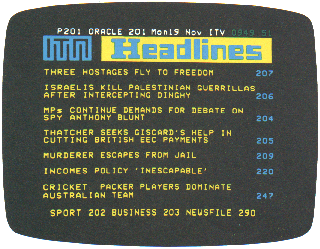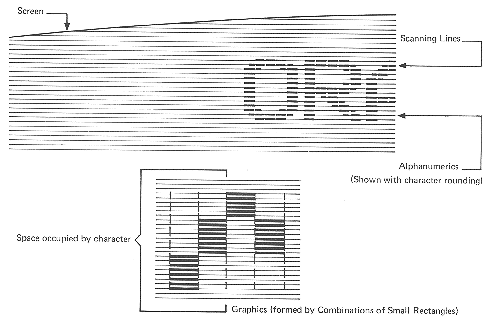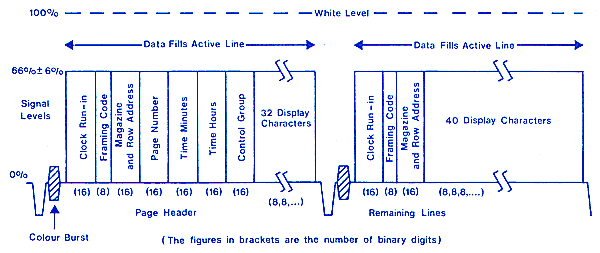 |
The Teletext Museum. |
|
|||||||||||
|
|
INFORMATION AT YOUR FINGERTIPS...
From an 8-page pamphlet published by the IBA Engineering Information
Service, January 1980.
Television and radio provide up-to-the-minute news and information; but, for many purposes, the written word is more useful. Written material has the advantage that it can be read at any pace, the reader can stop to think, perhaps re-read the text a number of times.
 ORACLE
retains the power of presenting the most immediate news and information
possible, yet combines it with the advantages of written material. Information
is transmitted alongside the television picture, and an ORACLE receiver extracts
and displays it in the form of characters and symbols on the television screen.
ORACLE
retains the power of presenting the most immediate news and information
possible, yet combines it with the advantages of written material. Information
is transmitted alongside the television picture, and an ORACLE receiver extracts
and displays it in the form of characters and symbols on the television screen.
An extra set of controls at the receiver allows the selection of any one of up to 8oo different pages. At any time the viewer can choose to watch either the normal television programmes or the ORACLE pages or even, on some receivers, the ORACLE pages superimposed upon the programmes.
The pages can contain anything that appeals to the viewing public. At the moment ORACLE offers an extensive range of the news and information that we need or are interested in, every day.
Choosing a page is even easier than dialling a telephone number, and the cost of an ORACLE receiver will be within reach of very many viewers.
ORACLE uses the broadcast television signal to carry extra information. These extra signals do not interfere with the transmission and reception of normal programmes. An ORACLE receiver - a television receiver with additional circuits - is capable of reconstructing written information and displaying it on the screen. The system allows the transmission of very many bulletins of information, and the viewer can choose any one by selecting a three-figure number on a set of controls - usually push buttons or thumbwheel switches. After a short interval the information appears and remains for as long as it is needed.
A major use of ORACLE is as an information service, but it can also supplement normal television programmes with sub-titles or linked pages.
The entire signal is accommodated within the existing 625-line television allocation, and so costs nothing in terms of radio frequency spectrum space. It is, effectively, the first broadcasting system to transmit information in digital form.
ORACLE was initially the product of a team of IBA engineers. The name is an acronym for Optional Reception of Announcements by Coded Line Electronics. A service with information generated by computer was demonstrated first by the IBA early in 1973. Later, the organisations with an interest in such systems came together, with the object of devising a unified standard. A specification for the resulting system was first published in 1974 but was later revised and issued in September 1976 [ref. 1]. The generic title 'Teletext' is now often used, but the name ORACLE remains for ITV's service. [No it doesn't - not since 1993! - mb21]
The first ORACLE system allowed up to 50 pages, with text in only one colour. Although the technical basis is similar, the current system is more attractive and flexible - with many more pages, colours, and other features. This new system is the result of co-operation and the pooling of ideas by UK Broadcasters and Receiver Manufacturers. In 1974 the Home Office authorised a trial period for experimental Teletext services and this period was extended in Autumn 1976. The ITV programme . companies have been providing an experimental service since mid-I975.
 ORACLE
pages look rather like pages of typescript, except that they can also include
large-sized letters and simple drawings. The photographs in this leaflet show a
few examples.
ORACLE
pages look rather like pages of typescript, except that they can also include
large-sized letters and simple drawings. The photographs in this leaflet show a
few examples.
The standard-sized words (like those in the central paragraph on the 'Consult the ORACLE' page) can use upper or lower case, and be in any one of -six colours red, green, blue, yellow, cyan and magenta - or white. The shape of the characters is usually based on a 7x5 dot matrix, with a refinement known as character rounding.
As many as 24 rows of the standard-sized characters can be fitted on a page, and each row can have up to 40 characters. Each page can carry about 150-200 words (about 3 paragraphs on this page).
The specification also allows the option of characters of twice the height of standard characters.
Larger-sized characters and also drawings are made by assembling small illuminated rectangles, each one-sixth the size of the space occupied by a standard character, and these too can be in any of the six colours or in white. The row at the top of the screen always has the same format. It contains the title ORACLE, the page number or a cycling page number (or both), the day and the date, an ITV identification and the time, exact to the nearest second.
The remaining 23 rows can be made up of rows or part rows of text or the 'graphic' forming rectangles.
Part or all of each page can be made to flash on-and-off (usually once per second), to emphasise any particular item.
The page background is usually black, although the specification allows the editor to define different background colours for part or all of the screen. Also, at the ORACLE editor's discretion, text can be enclosed in a black window and cut into the normal picture. Further, certain receiver designs allow the whole page (sometimes in white only) to be superimposed on the picture.
It is potentially possible for the system to carry up to 800 single pages; but because of the way the pages are transmitted, this could mean an appreciable waiting time between page selections. So for the moment not all 800 pages are used at any one time.

The ORACLE display - a schematic showing how the alphanumerics and graphics
are formed.
MAKING MORE ORACLE PAGES AVAILABLE
The number of different pages available can be extended in two special ways:
The ORACLE data is added to the normal television signal, and the combined signal is transmitted.
Pages are chosen on the ORACLE receiver merely by selecting a three-figure number.
Television picture transmissions are made up of a large number of horizontal lines, but not all the lines are used to form the picture. About 40 or so lines are arranged to be off the top of the screen - like a horizontal border at the top of a photograph. Into this border we put our ORACLE information.
A television picture is made up by interlacing two sets of 312½ lines, 25 times a second. Into the 17th and 18th lines of each of these two sets (in the second set they are called 330 and 331) the ORACLE information is inserted in the form of binary pulses. If the height control on a receiver is incorrectly adjusted it is possible to see these as lines of bright dots above the picture.
Each line of pulses contains the coded data for one row of standard size text or graphics rectangles. The rows for a given page are transmitted one after another until the page is complete, then the next page and so on, until all the pages have been transmitted. Then the cycle begins again. It's like a conveyer belt system, with coded rows of text continuously loaded on, one after another.
If every line of a page has text or graphics on it, the page takes 0.24 seconds to transmit. The total time to transmit the complete cycle of pages depends on how many pages there are, and how full they are. This cycle time represents the maximum waiting time for the appearance of apage after selection.
The binary pulses on the data lines are grouped into two sections. The first section establishes which row of text it is on the page, and the second defines what is to make up the row. Each letter, number, or graphic symbol is represented by an eight-digit binary number. For the first row of the page the first section also establishes which page is coming up, and its 'time-code'.

The position of the ORACLE data signals.
WHAT IS NEEDED TO RECEIVE ORACLE?
Additional circuits are needed in a television receiver to decode ORACLE. First, data extraction and recognition circuits examine the incoming 'conveyer belt' of ORACLE data lines, and extract those signals which make up the page which has been selected. The data from these lines is then stored (usually in an integrated circuit called a 'Random Access Memory') so that the page can be displayed at the same rate as a normal picture. The binary number codes are then translated to their corresponding characters or graphics patterns (in a 'Read Only Memory'). Finally a video raster scan representation of the page is switched onto the screen.
The reception of ORACLE, like normal television, is susceptible to various kinds of interference. IBA trials, however, indicate that the great majority of those who receive television pictures well, will also be able to receive ORACLE.

The ORACLE receiver system
 At the
moment ORACLE provides a news and information service, and Independent
Television is considering ways of extending the service. The ORACLE text can be
superimposed on the normal picture, so sub-titles or notes can be used to
supplement programmes. Particular interest is being shown in educational uses of
this.
At the
moment ORACLE provides a news and information service, and Independent
Television is considering ways of extending the service. The ORACLE text can be
superimposed on the normal picture, so sub-titles or notes can be used to
supplement programmes. Particular interest is being shown in educational uses of
this.
ORACLE signals originated in London are broadcast in other regions when the local ITV company uses programmes from London. When a programme company is using programmes originating outside London, usually locally, the data from London can be added by using a unit designed by ITV engineers and known as a data bridge. Data bridges are now installed in nearly all ITV regions and it is anticipated that, eventually, the ORACLE service will contain information generated in the local ITV region itself.
Interest in the current ORACLE development period, and the continuing work on ideas for extending the service, point to a very exciting future for ITV's ORACLE.
DATA
ORGANISATION OF DATA

ORACLE data organisation
Teletext Timeline | Teletext links
|
|||
|